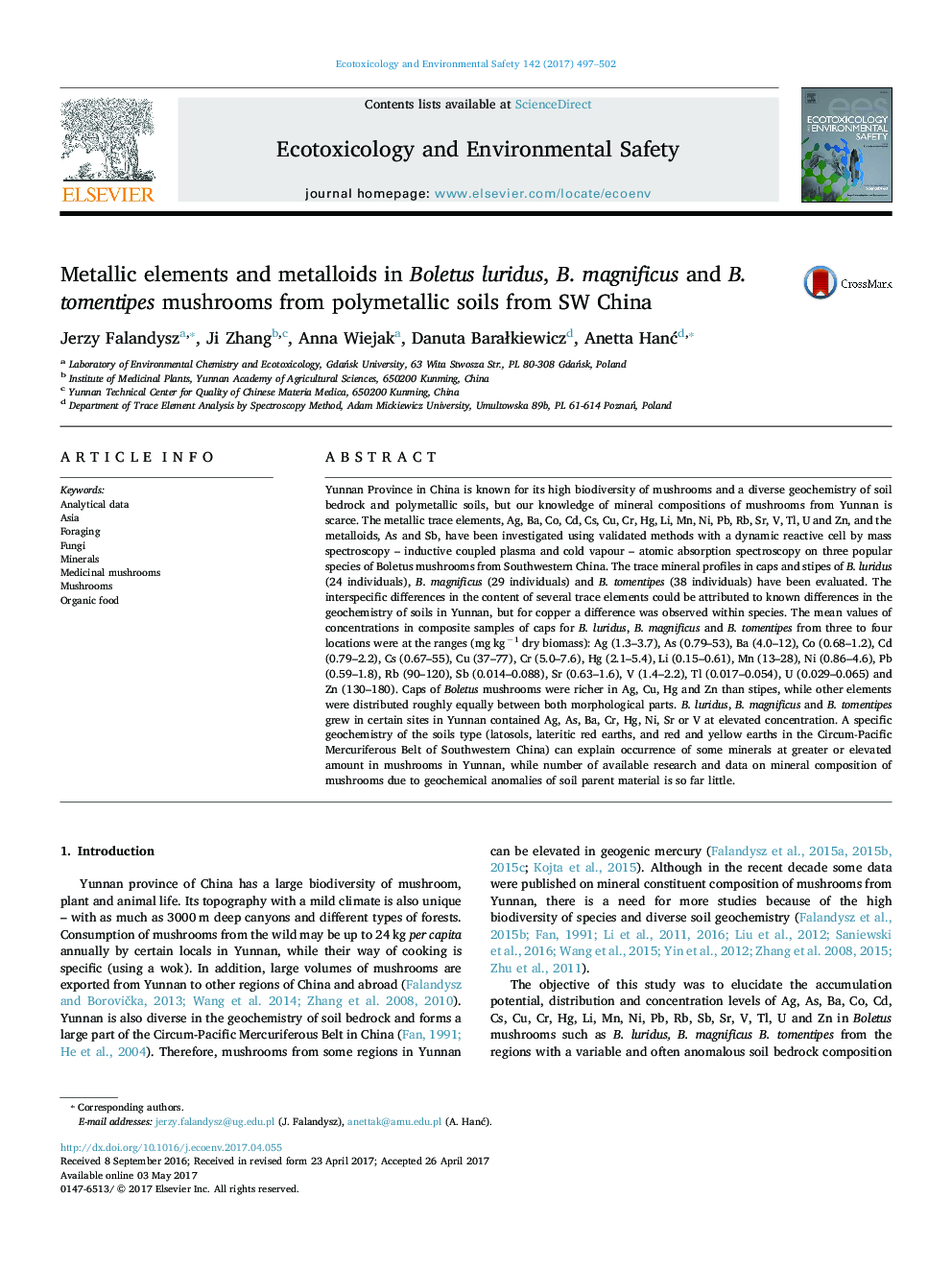| Article ID | Journal | Published Year | Pages | File Type |
|---|---|---|---|---|
| 5747658 | Ecotoxicology and Environmental Safety | 2017 | 6 Pages |
â¢Measured were Ag, As, Ba, Co, Cd, Cs, Cu, Cr, Hg, Li, Mn, Ni, Pb, Rb, Sb, Sr, V, Tl, U, Zn.â¢Variability of Cu within samples may indicate on species-specific difference.â¢Mushrooms contained varying amounts of As depending on a place.â¢Boletus spp. have the potential as bio-indicator of As geochemical anomaly.
Yunnan Province in China is known for its high biodiversity of mushrooms and a diverse geochemistry of soil bedrock and polymetallic soils, but our knowledge of mineral compositions of mushrooms from Yunnan is scarce. The metallic trace elements, Ag, Ba, Co, Cd, Cs, Cu, Cr, Hg, Li, Mn, Ni, Pb, Rb, Sr, V, Tl, U and Zn, and the metalloids, As and Sb, have been investigated using validated methods with a dynamic reactive cell by mass spectroscopy - inductive coupled plasma and cold vapour - atomic absorption spectroscopy on three popular species of Boletus mushrooms from Southwestern China. The trace mineral profiles in caps and stipes of B. luridus (24 individuals), B. magnificus (29 individuals) and B. tomentipes (38 individuals) have been evaluated. The interspecific differences in the content of several trace elements could be attributed to known differences in the geochemistry of soils in Yunnan, but for copper a difference was observed within species. The mean values of concentrations in composite samples of caps for B. luridus, B. magnificus and B. tomentipes from three to four locations were at the ranges (mg kgâ1 dry biomass): Ag (1.3-3.7), As (0.79-53), Ba (4.0-12), Co (0.68-1.2), Cd (0.79-2.2), Cs (0.67-55), Cu (37-77), Cr (5.0-7.6), Hg (2.1-5.4), Li (0.15-0.61), Mn (13-28), Ni (0.86-4.6), Pb (0.59-1.8), Rb (90-120), Sb (0.014-0.088), Sr (0.63-1.6), V (1.4-2.2), Tl (0.017-0.054), U (0.029-0.065) and Zn (130-180). Caps of Boletus mushrooms were richer in Ag, Cu, Hg and Zn than stipes, while other elements were distributed roughly equally between both morphological parts. B. luridus, B. magnificus and B. tomentipes grew in certain sites in Yunnan contained Ag, As, Ba, Cr, Hg, Ni, Sr or V at elevated concentration. A specific geochemistry of the soils type (latosols, lateritic red earths, and red and yellow earths in the Circum-Pacific Mercuriferous Belt of Southwestern China) can explain occurrence of some minerals at greater or elevated amount in mushrooms in Yunnan, while number of available research and data on mineral composition of mushrooms due to geochemical anomalies of soil parent material is so far little.
Graphical abstractDownload high-res image (257KB)Download full-size image
